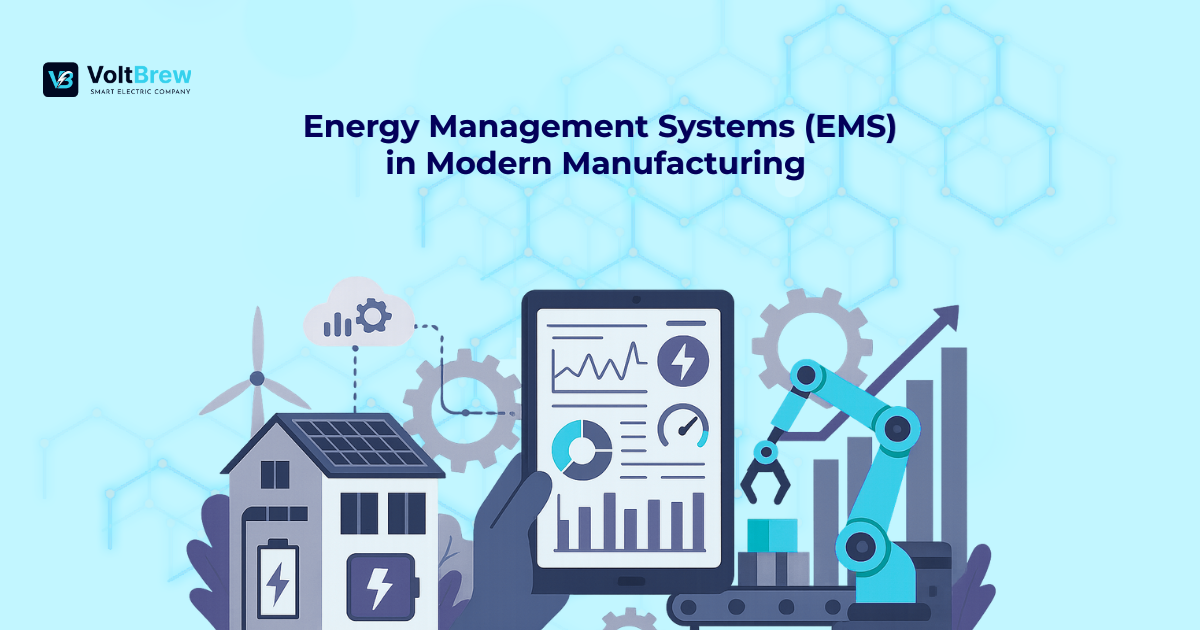As manufacturing becomes more intelligent, linked, and low-carbon, energy management has emerged as a critical driver of efficiency and competitiveness. Factories today are not just consumers of electricity, they are becoming active participants in energy markets, generators of renewable power, and even providers of grid stability. At the heart of this transformation is the Energy Management System (EMS), a platform that combines real-time data, automation, and analytics to optimize how energy is produced, consumed, and traded.
This blog explores how EMS is rebuilding global manufacturing, what problems it solves, and how technologies like demand response, energy storage, and distributed energy resources (DERs) are accelerating the industrial energy transition. As industrial networks evolve into smart cities and distributed energy ecosystems, platforms like VoltBrew are emerging as enablers of this shift.
The Growing Pressure on Manufacturers
Globally, the manufacturing sector accounts for over 37% of final electricity use and contributes to roughly 24% of direct CO₂ emissions, according to the International Energy Agency (IEA). While energy is important for production, it is also:
- A volatile cost input
- A source of regulatory Inspection (carbon emissions, ESG compliance)
- A constraint on operational resilience during grid instability
In emerging economies like India, manufacturers face additional challenges:
- Time-of-Day (ToD) tariffs and penalties from DISCOMs
- Unreliable grid supply, leading to dependence on backup generators
- Pressure to integrate rooftop solar or renewable energy PPAs
Traditional energy practices like fixed operating schedules and siloed utility billing no longer meet the demands of modern, data-driven production systems. This is where EMS comes into play, enabling cost optimization and grid participation.
What is an Energy Management System (EMS)?
An EMS is a digital platform that provides real-time visibility, control, and optimization of energy use in industrial facilities. It connects equipment, renewable energy sources, energy storage systems, and utility feeds into a unified control layer.
A modern EMS typically includes:
- Smart meters and IoT-based monitoring devices
- AI/ML-powered analytics and load forecasting
- Controls to program operations based on real-time conditions
- Dashboards for tracking KPIs like kWh/ton output, carbon intensity, or energy cost per unit
- Interfaces for connecting DERs like solar PV, batteries, and diesel gensets
EMS enables factories to shift from reactive energy use to proactive, predictive, and market-aware decision-making, making them key players in smart grid ecosystems and future-ready infrastructure.
Common Problems EMS Solves
1. High Energy Costs
EMS identifies energy-hungry processes, peak demand periods, and inefficiencies in real-time. It enables cost optimization by:
- Load shifting from peak to off-peak hours
- Curtailing non-essential processes during price spikes
- Using batteries for peak shaving
- Prioritizing renewable energy usage and grid arbitrage
2. Limited Visibility
Without sub-metering and analytics, most factories rely on monthly bills for insight. EMS offers minute-by-minute transparency, enabling better maintenance, planning, and resource allocation through real-time analytics.
3. Inflexibility
Legacy systems are rigid. EMS helps factories be more flexible by adjusting when energy prices change, dynamic scheduling, and remote control which is essential for factories participating in smart grid programs or VPPs (virtual power plants).
4. Inability to Leverage DERs
While many factories have solar rooftops or backup generators, they often lack proper coordination to use these resources efficiently. EMS synchronizes DERs, prioritizes clean generation, and uses energy storage efficiently. It also opens up peer-to-peer (P2P) energy trading opportunities and aligns with renewable energy mandates.
5. Grid Instability & Resilience Gaps
EMS detects anomalies, manages battery storage, and provides backup control strategies. In high-stakes production environments, this ensures uptime and protects critical loads, enhancing collaboration with DISCOMs and integrating with VPPs.
Key Features of Modern EMS:
- Real-Time Monitoring: Industrial IoT devices feed live data to the EMS dashboard. Managers can monitor consumption by process, line, shift, or even operator behavior with high accuracy.
- Load Forecasting: AI algorithms predict energy demand using production schedules, weather data (for solar generation), and historical consumption patterns. This forecasting is vital for balancing DERs and optimizing cost.
- Demand Response: EMS connects to utility APIs or third-party aggregators to participate in demand response programs. It creates a win-win: DISCOMs gain demand flexibility, and factories gain resilience and new income streams.
- Renewable Integration: EMS integrates on-site renewable energy, optimizes energy storage usage, and avoids back-feeding during low demand. This is crucial for DER-rich factories changing toward net-zero goals.
- P2P Trading & Grid Participation: Factories with surplus solar can trade with nearby facilities, participate in virtual power plants (VPPs), or provide backup services like frequency regulation all through peer-to-peer (P2P) networks powered by platforms like VoltBrew.
Case Study: How EMS Transformed an Indian Manufacturing Plant
A mid-sized electronics manufacturer in South India faced:
- ₹8 crore annual energy bills
- Frequent outages from the local DISCOM
- Underutilized rooftop solar system
- Diesel usage during peak hours
VoltBrew installed its EMS platform across the plant. Within 6 months:
- Energy costs dropped by 17%, through improved load shifting and solar prioritization
- Diesel use fell by 40%
- A 200 kWh battery was added and managed via EMS for peak shaving
- The factory earned ₹8.6 lakhs through demand response with the DISCOM
- It began trading excess solar with a nearby factory using a P2P framework
This digital transformation turned a grid-dependent facility into a flexible, grid-interactive prosumer hub—aligned with the goals of smart cities and India’s growing energy landscape.
Strategic Benefits
Cost Optimization
Energy consists of 30–50% operating expenses in energy-intensive sectors. EMS reduces waste, maximizes renewables, and automates arbitrage between grid and energy storage. The use of DERs and real-time analytics significantly enhances operational margins.
Carbon Reduction & ESG
EMS helps factories hit decarbonization targets, comply with sustainability standards, and access green finance or carbon credits—vital in an era of net-zero ambitions and climate accountability. VoltBrew’s EMS supports traceable renewable energy credits and emission reporting.
Resilience
Grid disruptions, price shocks, and regulatory changes are inevitable. EMS offers energy autonomy and visibility to direct them proactively. Participation in smart grid initiatives enhances long-term energy security.
Competitiveness
Energy-efficient factories have higher profit margins, better brand equity, and access to global green supply chains. They are also better positioned to participate in virtual power plants (VPPs), smart city energy programs, and peer-to-peer (P2P) energy networks.
How EMS Bridges Industrial Loads with Smart City Grids:
As India accelerates its smart cities mission, factories will act as critical infrastructure nodes—providing flexibility, fast-ramping loads, and DER coordination. EMS enables:
- Real-time data exchange with DISCOMs
- Participation in localized energy markets
- Shared energy services across industrial parks
- Adaptive energy usage based on city-wide grid conditions
- Integration into virtual power plant (VPP) networks
VoltBrew’s Energy Management System (EMS) connects factories to a larger network of distributed energy resources (DERs), smart grid systems, and flexible energy tools led by prosumers. This approach transforms manufacturers from passive energy users into active participants in grid stability, clean energy adoption, and cost-efficient operations.
Quick Snapshot Of Why EMS Matters:
| Benefit | Description |
| Cost Savings | 15–30% lower bills via automation and forecasting |
| Carbon Reduction | Up to 40% lower emissions with DER coordination |
| Grid Resilience | Higher uptime through P2P trading and storage |
| Market Participation | Revenue from DR, VPP, and ancillary services |
| Smart City Integration | Real-time coordination with DISCOMs and peers |
Thought Leadership: Energy is the Next Industrial Edge
In the Industry 4.0 era, manufacturers are no longer competing only on speed or cost, they’re gaining an edge through smarter energy use and real-time energy intelligence. With net-zero mandates looming, digital twins of energy systems, and AI-controlled microgrids, factories must view energy as a strategic input.
An EMS is no longer a nice-to-have as it’s the digital nervous system of energy-smart factories. It brings together smooth and efficient operations, cost control, and climate leadership in one flexible solution.
VoltBrew is leading this transformation by building the digital foundation for India’s distributed energy future connecting factories, DISCOMs, and DERs through an intelligent, stable, and compatible energy network.
Final Take
Energy Management Systems are building a new wave of transformation in manufacturing combining real-time control, DER integration, smart grid participation, and sustainability. Platforms like VoltBrew EMS are helping industries:
- Slash energy costs
- Improve uptime
- Trade and store energy wisely
- Engage with utilities and peers as prosumers
- Actively participate in smart cities and distributed energy models
As industrial energy shifts from centralized and passive to decentralized and intelligent, EMS will be the platform through which factories thrive.
Ready to transform your energy operations? VoltBrew can help.



